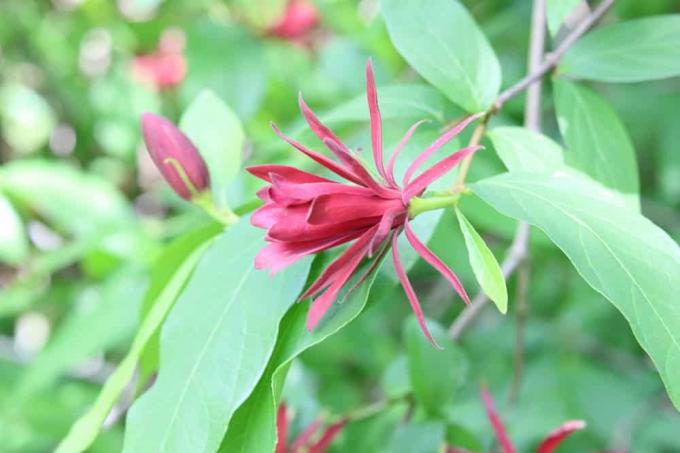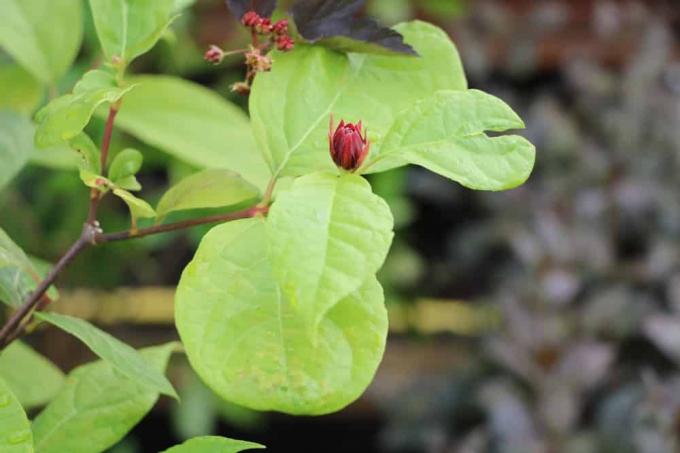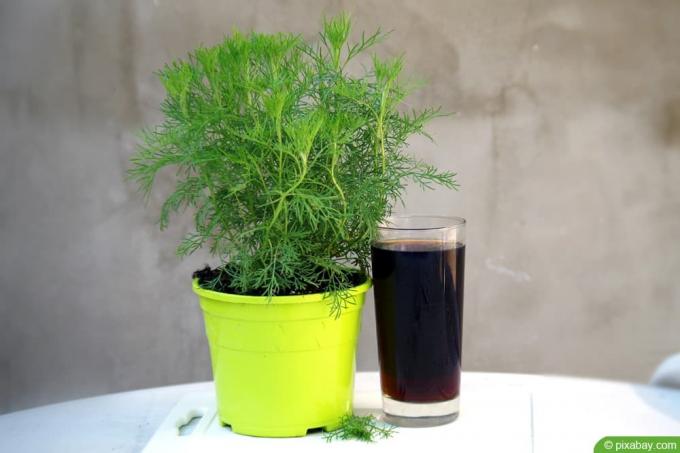

Table of contents
- PROFILE - Spice shrub
- Location and soil requirements
- Plant
- Fertilize
- Water
- Cut
- hardiness
- Care in the bucket
- propagation
- seed
- foothills
- cuttings
- lowering
- diseases and pests
- sorts
The true spice bush is a rarity as it is not often seen in the gardens. There are only a few varieties, although the shrub impresses with both its beautiful flowers and its fragrance. The plant is particularly attractive near terraces. It is very robust against diseases and pests and the care is not overly complex.
PROFILE - Spice shrub
- Latin name: Calycanthus floridus
- Synonym: Clove pepper, spice bush
- Hometown: Southeastern North America
- Growth: upright, bushy
- Height and width: 3 m high, 2 m wide
- Blossom: red or brown, May to June, scent of strawberries
- Fruit: capsule fruits
- leaf color: green, light green
- Particularities: fragrant, hardy, slightly poisonous, was used in small amounts by Indians as a spice
Location and soil requirements
In order for it to grow well, the clove pepper needs a suitable location in a protected location. Sun is suitable, but semi-shade is also suitable. The shrub does not tolerate midday sun very well. It also grows in the shade, but sufficient sunlight is important for the formation of the flowers and the pleasant scent.
The soil must be moist and nutrient-rich. Soil that is too wet needs good drainage, sandy soil is improved with humus or clay soil so that it can retain moisture better. Slightly acidic soil is well suited, which is why spice bushes like to grow in the company of rhododendrons.
Plant
The clove pepper is usually sold in pots. It should also be planted soon after purchase, as the pots on the market are often too small. If the shrub stays in the pot for too long, it can die. Plant in spring or early summer. It is important to have enough time before the first frost so that it has grown well.
- A hole is dug at the future location that is slightly deeper than the pot. The substrate is thoroughly loosened. If the soil is compacted, drainage made of gravel can be installed. Lean soil is upgraded with compost or dumped manure.
- The shrub is used, it should be planted just as deep as it was in the pot before.
- The hole is filled with nutrient-rich soil and the root area is covered with mulch made from lawn clippings or pieces of bark. The plant is watered thoroughly.
Fertilize

Water
Clove pepper needs a lot of water, especially in the growth phase. When young, it should be watered regularly. Later it is no longer so sensitive to drought, but it still needs additional water in dry and hot summers. Constant mulching of the root area keeps the soil moist and loose.
Cut
The shrub does not have to be cut every year, but it tolerates pruning well. It grows by itself in a loose form. As it ages, however, a pruning for rejuvenation can encourage flowering. To do this, the three or four oldest branches are cut out close to the ground. The clove pepper is cut during the dormant phase in winter. Then dead wood can also be removed.
hardiness
The clove pepper and its varieties are considered frost-resistant. However, while young, he is at risk of winter damage. The root area is covered with straw, leaves or brushwood. Frozen shoots can be cut back in spring.
A notice:
In very cold winters, a jute bag can be placed over the shoots of very young plants.
Care in the bucket
Under certain circumstances it is possible to keep a spice bush in a container. However, the shrub is not very suitable for this. It is not very heat tolerant and needs a lot of water. The substrate in a bucket dries out faster.
- Find a good location. In addition to sun or partial shade, a place is particularly well suited where the tub itself remains in the shade and only the shrub grows in the sun. This reduces evaporation and excessive heating of the substrate.
- The jar must be significantly larger than the pot in which the allspice was purchased.
- The substrate should consist of nutrient-rich soil. Normal potting soil for pot plants can be upgraded with compost.
- The bottom of the bucket is covered with gravel or potsherds so that excess water can drain off easily. Then the substrate is filled in and the plant used. The soil is filled in and pressed down well. Immediately after planting, it must be watered thoroughly.
- In the bucket, the shrub must be watered regularly, the soil must never dry out completely. A layer of mulch also reduces evaporation. This should always be renewed if it becomes too thin.
- In addition to water, the spice bush in the bucket also often needs fertilizer.
- Overwintering in the bucket is not as easy as outdoors, even if the plant is basically hardy. Potting soil freezes faster. That's why winter protection can't hurt. The pot is best wrapped or placed in fleece.
propagation

There are several ways to propagate the allspice pepper.
seed
- suitable for the wild species of Calycanthus
- harvest ripe fruit in October/November
- Shake out seeds
- sow directly outdoors in seed trays
- during the winter the germination inhibition is broken
- the seed sprout in spring
- separate young plants into pots
- when they are stronger and larger, they can go outdoors
foothills
- one of the easiest ways to propagate the shrub
- in autumn, root suckers are cut off with a spade
- the section is transplanted to the new location
- the shoots are cut back to 10 cm, which promotes branching
- winter protection can be helpful
cuttings
- more for professionals
- Mother plant should be young and vigorous
- cut flowerless, unwoody shoots in June
- Growing bed with underfloor heating and growing soil
- Cut the cuttings at the bottom side
- dip in rooting powder and stick into the soil
- it takes a while for the shoots to root, after which they can be isolated
lowering
- suitable for all varieties and hybrids
- long, lateral shoot is buried in the middle in spring
- fix with ground anchor
- by autumn roots have formed
- Cut off and transplant shoots next spring
diseases and pests
The shrub is not very sensitive. Specific diseases are not known. Sometimes the shoots, especially the young ones, are infested with aphids. On the one hand, beneficial insects help and, on the other hand, they can be rinsed off with a hard jet of water. If the leaves are wilted, the root area should be checked. Not only drought can be the cause. Waterlogging is also reflected in the same symptoms. The roots begin to rot and can no longer supply the shoots with enough water and nutrients. Discolored leaves, especially if they turn brown, can be the result of too much sun exposure. Too much sun also causes the edges of the petals to dry out.
Tip:
With a little patience, the allspice can also get used to the midday sun without any signs of burning.
sorts

Some attractive hybrids have been created by crossing the Chinese wax or spice bush (Sinocalycanthus chinensis). However, there are hardly any seed-solid cultivars of the real spice bush on the market.
Aphrodite
This shrub stays a little smaller than the real spice bush. It will be 2.50 m wide and just as high. The flowers are burgundy but have a white or cream center. The flowering period is longer than that of the real spice bush and lasts from May to September.
Hartlage Wine
This variety grows very sprawling and is more wide than tall. The flower is up to 9 cm in diameter and is light red with a creamy white centre. The flowering time is similar to that of the real spice bush.
Venus (Calycantus venus)
The flowers of this strain are very large at 11 cm. They are white with a reddish center. The Calycanthus venus grows bushy up to 3 m high and is therefore similar to the real spice bush. The flowering time is also the same.
 garden editorial
garden editorial I write about everything that interests me in my garden.
Learn more about herbal recipes

Make herbal lemonade yourself | 12 delicious recipes
Herbal lemonades are delicious, thirst-quenching and healthy and easy to make yourself with the right recipe. A long-lasting supply can be built up with homemade syrup made from herbs. At Hausgarten.net you will find the best recipes to make yourself.

Make herbal salt yourself | 7 recipes for fresh & dried herbs
Making herbal salt yourself is easy and practical. Because fresh herbs can easily be preserved with it and an individual spice mixture can be prepared. Suitable recipes for fresh and dried herbs can be found here.

Colakraut Syrup - How to make cola without caffeine & 4 delicious recipes
Colakraut is also known under the name southernwood and has - as the name already suggests - an intense cola aroma. With the right recipes, syrup, lemonade and liqueur can be made from it. Here we tell you how you can do it yourself.

15 tips for cutting, propagating, harvesting & drying olive herb
While thyme can be found in almost every herb bed, the olive herb is considered an exotic rarity with its comparable, spicy taste. The gardener gives a lot of thought to the preservation of the small peculiarities of his garden. "How should I prune the plant and when can I harvest the herb?" In this guide he will find 15 helpful tips for the right cut, propagation and subsequent use.

Make your own herbal liqueur 5 recipes for herbal schnapps
After a hearty meal or when you have a stomach ache, a herbal schnapps works wonders. Icons in the herbal liqueur heaven, such as Jägermeister and Ramazotti, demonstrate a variety of pleasure variations and strictly guard their legendary recipes. These 5 recipes for herbal schnapps reveal how you can easily make the beneficial spirit drink yourself.

Salad herbs: 11 classic herbs for the salad | make mix
If you like to eat salad, you also need a lot of herbs for the good taste. The mixture is quick and easy to make yourself, especially if the salad herbs are growing in your own garden bed or window box. The salad can be designed so that it tastes different again and again.
